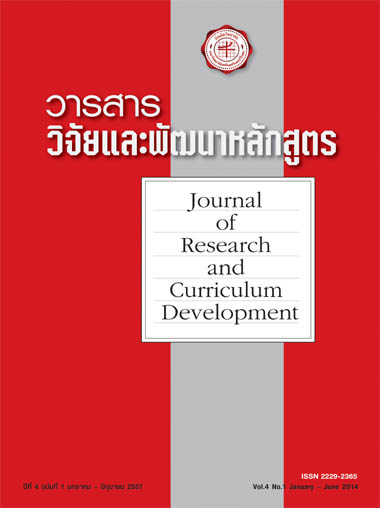การสร้างแผนที่ตัวแปรเชิงทฤษฎี: แนวทางการสร้างโมเดลความคิดในระบบการประเมินที่ถูกต้องและน่าเชื่อถือ
Keywords:
แผนที่ตัวแปรเชิงทฤษฎี, ระบบการประเมินที่ถูกต้องน่าเชื่อถือ, การสร้างโมเดลความคิด, โมเดลการตอบสนองข้อสอบ, construct map, valid assessment system, cognition modeling, item responseAbstract
ระบบการประเมินที่ถูกต้องและน่าเชื่อถือประกอบด้วยองค์ประกอบสำคัญ 3 ส่วนที่เชื่อมโยงต่อเนื่องกันคือ โมเดลความคิด ค่าสังเกตหรือข้อมูล และการแปลความหมายผลวิเคราะห์ข้อมูลที่เชื่อมโยงกลับไปยังโมเดลความคิดในตอนต้นของระบบการประเมิน โดยทั่วไป โมเดลความคิดเป็นองค์ประกอบที่ถูกละเลยในระบบการประเมินทางการศึกษาและจิตวิทยา ทำให้ค่าสังเกตหรือผลวิเคราะห์ข้อมูลไม่สามารถแปลความหมายและสรุปอ้างอิงเกี่ยวกับความสามารถของบุคคลได้อย่างถูกต้องและน่าเชื่อถือ วัตถุประสงค์ของบทความนี้ เพื่อนำเสนอวิธีสร้างโมเดลความคิดที่เรียกว่าการสร้างแผนที่ตัวแปรเชิงทฤษฎี โดยมีแนวคิดสำคัญคือ การจำแนกความสามารถแฝงหรือคุณลักษณะแฝของบุคคลตามระดับหรือปริมาณของการมีความสามารถแฝงนั้นหรือคุณลักษณะแฝงนั้นภายใต้กรอบแนวคิดทฤษฎี โดยใช้ผลการตอบข้อคำถามที่สร้างขึ้นตามโมเดลความคิด การสร้างแผนที่ตัวแปรเชิงทฤษฎีเป็นกระบวนการที่ไม่ซับซ้อน มีขั้นตอนที่เป็นระบบชัดเจนและไม่ทำให้ระบบการประเมินที่มีอยู่เดิมยุ่งยาก และยังสามารถประยุกต์ใช้ในระบบการประเมินแทบทุกประเภท การวัดหรือผลการวิเคราะห์ข้อมูลมีความถูกต้องมากยิ่งขึ้นแล้ว ยังให้ข้อมูลย้อนกลับเพื่อปรับปรุงโมเดลความคิดบนพื้นฐานของทฤษฎีการตอบสนองข้อสอบ ปรับปรุงข้อคำถามให้สอดคล้องกับโมเดลความคิด และปรับปรุงเกณฑ์การให้คะแนนให้มีความเป็นปรนัยมากขึ้น รวมถึงเป็นหลักฐานสำคัญในกระบวนการตรวจสอบความตรงเชิงโครงสร้างของการประเมินอีกด้วย
Construct Mapping: An Approach of Cognition Modeling in Valid Assessment Systems
A valid assessment system is comprised of three necessary components connected to one another-a model of cognition, observations, and interpretation of analysis results which articulates the model of cognition at the beginning of the assessment system. In general, a model of cognition is overlooked in educational and psychological assessment systems. This yields observations and analysis results that cannot be used for making valid interpretation and inference about the examinee's ability. The purpose of this article is to introduce an alternative approach to constructing a model of cognition, called "construct mapping." The key concept of construct mapping is to classify attributes, which describe a latent trait, aligned with a postulated continuous scale. This is done by using the examinees' item responses to items that correspond with a model of cognition to understand the quantity or magnitude of possessing the latent trait under a theoretical framework of interest. Construct mapping is an uncomplicated and systematic process; it is easily adaptable to any kind of existing assessment system. The advantages of construct mapping are not only to support interpreting test results or analysis results more appropriately, but also, construct mapping allows for the following: 1) To give promising feedback in order to improve the model of cognition according to item response theory; 2) To revise items to correspond to the model of cognition; 3) To maximize the objectivity of a scoring guide, and 4) To be used as evidence in investigating the construct validity of an assessment.





